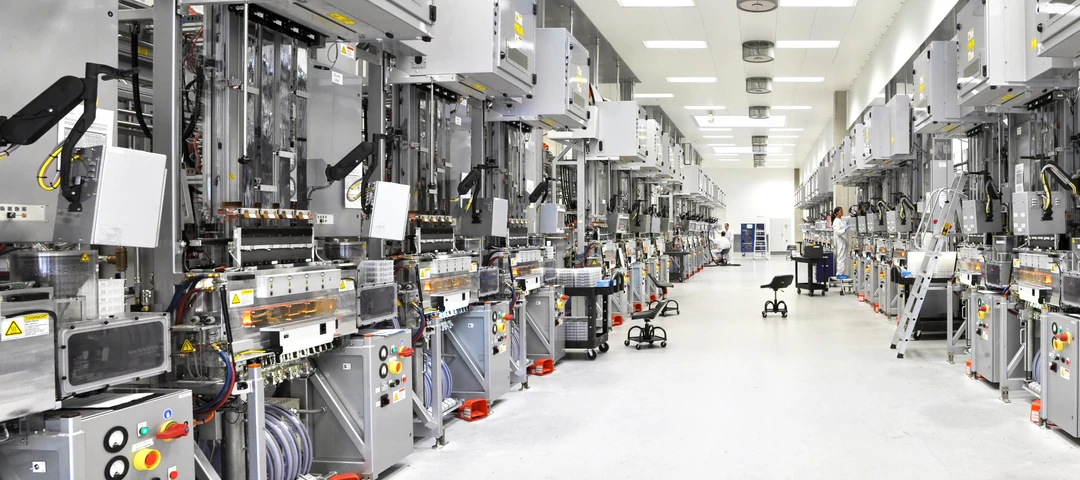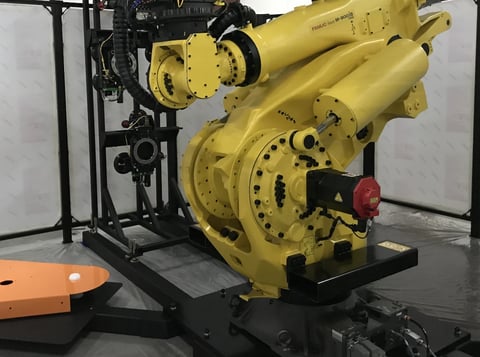6 Machine Base Frame Design Guidelines

Are machines the heart of your operation? Well-designed machine bases serve as not just their skeleton, but their veins and arteries too, keeping circulation (aka your production process) healthy and flowing.
It’s easy to get lost in the details of how your devices will perform their delicate, intricate functions. But if you want those functions at peak performance for their full service life, start at the base.
Consider these six factors of success for your next steel or aluminum frame design, especially if you’re designing a custom machine base.
Machine Base Frame Design Considerations for Industrial Use
Lean on these guiding principles for your next machine base frame design, especially if you haven’t selected your material or manufacturing method yet:
- Precision
- Adjustability
- Load capacity
- Safety
- Accessibility
- Base, guard, or enclosure … or all of the above?
1. Precision
How important is steady alignment to your use case? Industrial machinery designs generally require high precision, but some applications are particularly touchy, such as:
- Mobile robot bases
- Medical & lab equipment stands
- Laser cutter frames
Many of these applications are meant for several years of expected high performance. The more permanent and high-stakes your machine setup is, the more durable your design must be.
Steel machine bases offer rigidity that standard aluminum bases can’t match. Their welded, stiff connections ensure the frame won’t loosen during shaking or transportation.
*Note that we praised the durability of steel over standard aluminum. This is where structural engineers tend to overdesign with excess material – both in type and quantity.
Not all aluminum structural frames are created equal in machinery applications. Traditional T-slot framing systems, made of extruded aluminum, use cheap hinges and crudely engineered brackets with minimal ability to hold up over time. But where T-slots loosen and fail in heavy-duty machinery, newer aluminum framing technology is taking over.
These newer systems are self-aligning, meaning they use angled bolts and high-strength brackets to mechanically lock, essentially becoming vibration-proof.
Self-aligning aluminum framing opens a variety of design possibilities for many manufacturing situations:
- When parallel planes and level tops are important to performance requirements. These are easy to achieve and maintain with high-precision components.
- When you could use a smooth-operating bi-fold door. Stacking hinges with T-slots results in a huge range of error, but with self-aligning systems the compounding is minimal.
- When you want a system as durable as steel with the corrosion resistance and other benefits of aluminum.

2. Adjustability
Whether on the factory floor or in a medical lab, a machine base needs to be light on its feet – literally and figuratively.
Modularity
Would your operation be more efficient if setup was faster and more flexible? While both aluminum and steel frame suppliers market their products as “modular,” only aluminum framing systems offer true modularity.
There’s a resignation among designers that an industrial machine base must be some welded, immovable monstrosity. Bases for mobile and other versatile machines can add much more utility if they’re fully adjustable – a feature you can achieve with aluminum. Instead of being segmented into upper and lower halves of legs, your machine frame assembly can be just one piece! (More on this in #6.)
*Note that assembly is 50% quicker with self-aligning aluminum structures, so consider the extra investment if your application includes frequent setup, teardown, and transport.
Weight
Any machine you want to move often will become the team’s worst enemy if it’s needlessly heavy.
A clear illustration of this issue is a machine tending cell.
This cell basically operates at a precision-aligned machine, and when that job’s done, a worker rolls it over to another machine. That might happen 5-6 times in a year. Disassembly isn’t an option – so why build a big, heavy base that’s a pain to roll?
Aluminum extrusion framing systems are nearly 3x lighter than steel alternatives. Movement isn’t just quicker, it’s safer, too.
What’s more, the lightweight requirement of your product doesn’t have to come at the expense of strength …
3. Load Capacity
The strength of your metal framing system will determine the true capabilities of your machine base.
If your design needs pure power, and weight isn’t a concern, a steel frame base may still be your best bet. It’s a fairly cost-effective blend of high strength and long-term stability.
However, when your list of criteria stretches beyond brute force, consider aluminum framing.
Aluminum extrusions can hold more weight than you might think. Pound for pound, it actually owns a higher strength-weight ratio than steel.
This is another design requirement where you’ll want to invest in self-aligning aluminum framing to rival the strength of steel. T-slot frames are inherently weak at their connection points, while self-aligning brackets are uniquely engineered to optimize profile strength.
With proper engineering, aluminum supports work so efficiently that you can reduce the brackets and cross-members in your design. This lowers material cost, improves sight lines, and reduces weight.
The superior heftiness-to-heaviness ratio of aluminum makes it valuable for highly dynamic designs, like mobile robot bases and stands.
4. Safety
Your decisions in the conceptual stage can impact both the immediate and long-term safety of your machine application.
Example #1: Jamming or sagging doors
A machine with bad doors isn’t inherently evil. However, in factories, workers often brush aside safety requirements in favor of staying on schedule. If a door with a safety latch is out of alignment, chances are someone on the floor will throw a rag on it and override the e-stop.
No maintenance or engineering manager wants to hear that. Steel and self-aligning aluminum frames keep safety features safe – for years to come. Their predictable stability gives you peace of mind that your employees won’t need to exploit loopholes in the safety system.
Example #2: Flaking framing
You’ve got an application where contamination would compromise machine performance or the safety of nearby life:
- Bearing machine or press
- Sand blaster
- Automated paint line
- Medical equipment
- Cleanroom equipment
Steel, especially when not properly finished, will corrode. When rust particles flake off and enter certain machines, they can compromise output quality or cause machine failure.
In applications where you can’t afford to have airborne contaminants enter machines or lungs, veer away from carbon steel. Even painted or powder-coated carbon steel lacks the innate self-preserving properties and anodized protective layer standard to aluminum profiles.
Machine bases made from aluminum don’t degrade under standard operating conditions and therefore don’t put flakes into the air. You can reinforce these profiles with architectural-grade anodizing to make them even more durable in harsh environments.
5. Accessibility
The faster and safer it is to access important devices, the smoother your run time will be.
How often will humans need to access the machine? Consider your application’s accessibility needs for:
- Everyday use
- Maintenance
- Repairs
- Modifications
Take stock of any visibility requirements for your project, and whether you can build a leaner machine to improve speed and ease of use.
When it comes to operator access, there are cases for and against immediately reaching for the premium option, self-aligning extrusion systems. Because these framing components form bonded connections that maximize profile strength, they require less bracketry and cross-bracing. Fewer components means a better view of what’s inside the enclosure.
One disadvantage of self-aligning framing is that if you design it as a single assembly, it’s harder to set up inside the enclosure. You can still install the panels late in the assembly to maintain a decent level of access, so this drawback is minor. Few internal components are big enough to cause much of an obstruction, and you can always build a bigger enclosure.
*Note that a framing system that self-tightens with vibration will require little to no maintenance. Compared to T-slot systems, this option reduces operators’ need to access the machine in the first place.
6. Base + Guard + Enclosure
Have you been building machines with adjustable, T-slotted guarding and a welded, immovable steel base? This Frankenstein approach has been unnecessary for years and, like Frankenstein, stiff in all the wrong ways.
When total cost of ownership is a project priority, use a single material and process to create a single-piece assembly. This doesn’t just apply to the base, mount, or stand. Fully integrated systems allow you to combine the:
- Base
- Guarding
- Enclosure
There are several benefits to designing machine framing as a cohesive unit. With the right engineering choices, all of them reduce project costs too.
- Strength & stability – fewer connections = fewer points of failure
- Streamlined orders & assembly – base and enclosure can share some supports
- Aesthetics – uniform structure instead of piecemealing of multiple materials
- One-stop shop – eliminating extra third parties means quicker lead times and fewer chances for miscommunication
With these benefits in mind … do you decide to weld the whole thing? Use T-slots throughout? That depends on how you view the first five points through the lens of your specific application.
For our money (and your money), T-slot alternatives offer the most bang per buck despite using premium components. Self-aligning extrusion systems get more work done with fewer pieces and less weight, supporting easy assembly and maintenance of machinery head-to-toe.
What Can You Accomplish With a Sturdy-Yet-Adjustable Base?
Industrial settings often call for custom, highly engineered structural support. Your machine design choices will come down to matching your budget to the project’s performance expectations.
Look to …
- Steel when you need strength, reliability & safety
- T-slots when you need modularity
- Self-aligning systems when you need all of the above
Ready to lower your total cost of ownership and protect the lifeblood of your operation with aluminum machine frames? Visit our resource center for more tips on designing for operational safety and productivity:



Leave a Comment